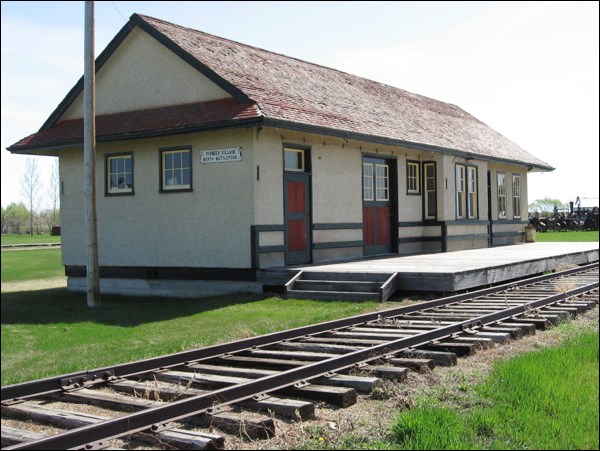One hundred years ago, a plaintive whistle in the distance sent town folks scurrying to the railway station to meet new arrivals or to pick up their catalogue mail order or long-awaited letters from home. Knitting together far-flung prairie towns and villages, the railway was a vital link between the prairie frontier and the outside world. Imagine the anticipation of those in the waiting room longing for their first glimpse of family or friends.
The Canadian Northern Railway built a station in Prince in 1913. It was a boom time for railways in Saskatchewan, with hundreds of kilometres of track laid, forming a conduit for prairie grain to reach distant markets. More often than not, the railway station was the first seed needed to plant a prairie town.
But by 1918 the Canadian Northern Railway was in the red. When the Canadian National Railway (CNR) formed in 1919, bringing together the Canadian Northern and eventually the Grand Truck Pacific Railway, the Prince station was brought into the CNR web.
In 1928, the station at Prince was rebuilt using CNR Plan 100-220. Records show the rebuild cost $6,500. While the station was designed to meet the transportation needs of Prince and the surrounding farm community, it was also intended as a structure of community pride. In 1928 folks frequenting the station at Prince anticipated a busy and bright future.
Early stations were almost always wood construction but by 1928, when the Prince station was rebuilt, the CNR was in the habit of stuccoing the exterior to add class to the station. This station still bears a striking resemblance to the Canadian Northern fourth class depot design, intended for small communities, with no second storey and a plain roofline. The Canadian National fourth class took the Prince station up a notch, with gable dormers to break up the roofline. The station had a greater width with the protrusion of the living quarters.
The CNR station operated in Prince for 40 years. The freight office was always a popular spot as goods and mail arrived in the lonely prairie outpost. Farmers shipped out grain and other farm products to distant markets. They took delivery of threshing machines and new tractors arriving by rail from the East.
The station also provided a home for the station master and his family. The last agent in Prince was Mel Martin. The station closed in 1953 at which time Martine Zary and his family moved into the living quarters. Zary acted as caretaker and section foreman until he retired in 1956.
The end of the Second World War brought changes to railway operations. With the introduction of centralized traffic control, local agents were no longer needed for train schedule control. All-weather roads and the growing availability, affordability and popularity of automobiles were other factors in the decline of local stations. Train passenger service declined in direct proportion to the rise of automobiles. In 1925 there had been 79,383 motor vehicle licences issued. By 1955, that had increased to 267,373.
Last used in 1957, the station was moved to the Heritage Village at the North Battleford Western Development Museum (WDM) in 1967, Canada's centennial year. It took three years before renovations and rebuilding were completed and the building opened to museum visitors.
Next year our railway station celebrates its 100th birthday. Not surprisingly, after so long, it needs a new roof. Museum staff and supporters are working hard to meet the challenge.
Locomotive 1158
Locomotive 1158, a Type 4-6-0 Class G, was built in 1913 by Montreal Locomotive Works in Quebec for the Canadian Northern Railway. It carried 10,160 kilograms (10 tons) of coal and 19,000 litres (5,000 gallons) of water.
These locomotives earned reputations as prairie steam workhorses on the Canadian Northern and, after 1919, on the Canadian National Railway (CNR). Such locomotives brought new farmers to the west, and hauled their grain to market.
Locomotive 1158 was used on mainline passenger service before it was relegated to freight and branch line work. It was last used at Blue River, B.C. as a switching engine. In 1960, it was retired, donated by the CNR and moved to the Western Development Museum in Saskatchewan.




